CHAPTER V
THE CITY OF WAHOO
THE NAME OF WAHOO
As narrated elsewhere the site of Wahoo was in the early days the scene of a favorite camping ground of the Otoes, a noted tribe of Indians who once owned all the lands south of the Platte River. It is said by some that the town received the name of Wahoo from these Amerind inhabitants. However, there has ever been a great dispute over the origin of the name. One explanation is that it derives its name from the "Euonymus," or "Wahoo," sometimes called the "burning bush," which once grew in abundance along the banks of the Wahoo Creek, upon which the site of the old encampment borders. It is a well known fact that the creek in question received its name from the Wahoo and that this shrub was the favorite medicinal plant of the Indians, that the Wahoo was their principal camping ground, and the spot where they interred their dead. In matter of fact, the site was a permanent village. These few facts tend to show that the name came from the "wahoo shrub" and the home of the medicine man of the tribe. Another explanation is that the name Wahoo is corrupted from the name Pahoo, meaning "few bluffs," in opposition to the word Pohoc which means "many bluffs," and from which the name Pohocco headlands is derived. J. R. Lee, an old settler, once claimed that he, a Mr. Hawthorne and a Mr. Barnard, named Wahoo. He said, "As near as I can remember, in talking to the Pawnees, they told me that Wahoo Creek was named from a round bluff near Ithaca, called Pawhoo, which means round bluff, as Pawhock means Cedar bluff. We called it Pawhocco and we called Pawhoo Wahoo. We named Wahoo from the creek as we thought it would be a good name for the town."
77
78 PAST AND PRESENT OF SAUNDERS COUNTY
The above explanations of the name of Wahoo are confusing as well as contradictory. The veracity of the different stories will be questioned, which is unfair, as the only record for this information is principally legendary facts and as such they must be taken.
FIRST SETTLEMENTS
The first settlement made in the precinct occupied by the City of Wahoo was by Moses Stocking in the year 1865. Four years later, in 1869, J. M. Lee and J. R. Lee located upon section 4, town 14, range 7 east, the original site of the town. In 1870 a company composed of J. M. and J. R. Lee, William B. Lee, H. Dorsey, E. H. Barnard, J. J. Hawthorn and a man named Miner made claim to the town site, surveyed the land, and subsequently became the original proprietors of the village.
J. M. Lee constructed the first house in the village in 1869 and opened the first store. He carried a line of general merchandise which he sold or, generally, traded to the few settlers. Dayton Andrews and Charles P. Beebe came to Wahoo in 1872. Here Mr. Beebe, in partnership with Mr. Lee, opened the second store in the village, and in the fall of the same year Dayton Andrews also opened up a general merchandise business, thus making three stores in the new town. John Stevens erected the first hotel in 1869 and gave it the name of the Wahoo House. This was the only hostelry until 1878, at which time Dr. R. B. Morton built the Commercial Hotel. John Bracken commenced business as a blacksmith in 1869.
Dr. R. B. Morton settled upon his homestead in 1870 and in 1874 opened the first drug store in Wahoo. He was credited as being the pioneer physician in this part of the county. Dayton Andrews was the first justice of the peace; Frank Dean and X. H. Bell were the first to represent the legal profession in this field, the former locating in 1870 and the latter sometime later. N. H. Barnes started the first hardware store in Wahoo in 1874 in the form of a tin-shop. He gradually added a stock of hardware. The first furniture store in the town was started by John Beermaker who came in 1874. The next year he added the hardware business. The first brewery started in Saunders County
PAST AND PRESENT OF SAUNDERS COUNTY 79
was by Anton Jausa in 1880; it was erected in Wahoo. Otto Ostenberg came to Wahoo in 1876 and started the first elevator, erecting the same. He was the first grain buyer in the town. Among the first carpenters of the town was Isaac E. Phelps. He settled here in the spring of 1874, and built most of the early buildings of the town, including the frame courthouse. Thomas Rance came to the town in 1879 and started the first carriage factory. The first photographer, James B. Sturdevant, opened the business in Wahoo in 1871; he had previously, 1869, settled on a farm.
GOVERNMENTAL AFFAIRS
The removal of the county seat from Ashland to Wahoo in 1873 virtually decided the fate of the latter community. At a meeting of the board of county commissioners held September 1, 1874, the following petition appears of record; "Now comes H. D. Perky in behalf of the citizens of the Town of Wahoo, and presents a petition, signed by a majority of the taxable inhabitants of said town, asking that said town be incorporated as provided by Chapter 81 of the Revised Statutes of Nebraska." The board, finding the provisions of the petition correct and the whole in conformity to the law, ordered that Wahoo be incorporated, the following boundaries to be of the territory included in the corporation: the west half of section 3, except a strip of the south side, 641 feet wide, and the east half of the south quarter of section 4, all in town 14 north, range 7 east of the sixth principle meridian, in the county. It was further ordered that Charles Beebe, H. D. Perky, D. Andrews, E. Pickett, and M. B. Reese be appointed trustees for the Town of Wahoo.
The trustees appointed by the board of county commissioners met at the law office of Thompson & Reese and formally organized the Town of Wahoo on September 3, 1874, and elected Dayton Andrews as chairman of the board, appointed J. R. Gilkeson as clerk, C. M. Burr as treasurer, and Harmon Gilkeson as marshal. From the records it appears that N. H. Bell qualified as clerk and took the seat of office. At a meeting held February 4, 187o, J. A. Knepper was appointed town clerk and on April 5, of the same year, J. C. Saylor was appointed.
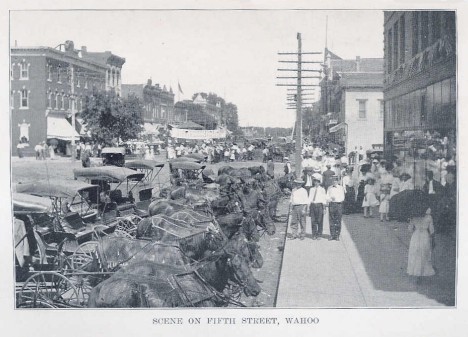
Scene on Fifth Street, Wahoo
80 PAST AND PRESENT OF SAUNDERS COUNTY
The first town election was held at the courthouse on May 5, 1875. M. B. Reese, E. Pickett, J. W. Perkins, J. R. Gilkeson, C. P. Beebe were chosen as town trustees. The board met and elected M. B. Reese as chairman and appointed the following: J. A. Knepper, town clerk; R. H. Knapp, treasurer; and L. E. Barnhouse, marshal. In 1876 the election was held on May 8th and the following were elected trustees: Henry Anderson, M. B. Reese, R. H. Knapp, I. R. Mengel, G. W. Burton; these men then chose M. B. Reese as chairman, J. G. Saylor as clerk, R. II. Knapp as treasurer, H. Anderson and I. R. Mengel a committee on fire and water, R. H. Knapp and G. W. Burton as a committee on finance. At a meeting of the board held December 6, 1876, C. F. Williams was appointed town clerk, and a petition, signed by the citizens of Wahoo, for further protection against fire, was laid before the board May 14, 1877. At the election of 1877 Messrs. Burr, Knapp, Koudelle, Reese and Stratton were elected town trustees. Mr. Knapp was elected chairman, C. F. Williams was appointed town clerk, and H. Anderson, treasurer. C. M. Burr and V. M. Stratton formed the committee on finances, M. B. Reese and P. Koudelle, the committee on fire and water, and C. M. Burr and F. M. Stratton, the committee on streets and alleys.
In March, 1878, Wahoo decided to try the city form of government and accordingly on April 6th an election was held and the following city officers chosen: R. H. Knapp, mayor; J. A. Smith, clerk; Charles Perky, treasurer; Arthur Perry, marshal; John Mosher, police judge; W. H. Dickinson, engineer; councilmen, C. H. Burr, E. E. Lyle and Mr. Clapp, X. H. Bell, Frank Koudelle, X. R. Gregory, E. Pickett. The judges of election were: G. W. Chase, C. Beebe, P. Marsh, J. I.. Reed, F. Koudelle, W. G. Keefer, W. Andrews, X. R. Gregory. The clerks of election were: C. S. Johnson, E. Price, M. I.. Ells-worth, George Ebling, H. Brown and L. T. Burnett.
Pursuant to a call the mayor and the council met on April 10, 1878, and declared Wahoo a city of the second class and elected N. H. Bell as president of the council. At this meeting F. M. Stratton appeared before the board and stated that he was still a member of the board of trustees of the Town of Wahoo and asked to be allowed to act in this official capacity. The board
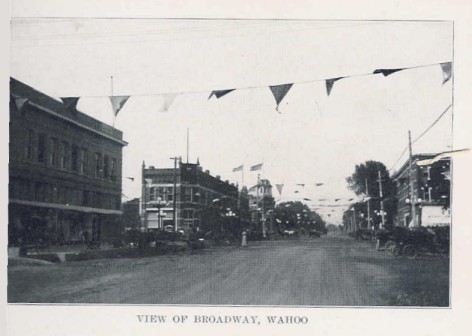
View of Broadway, Wahoo
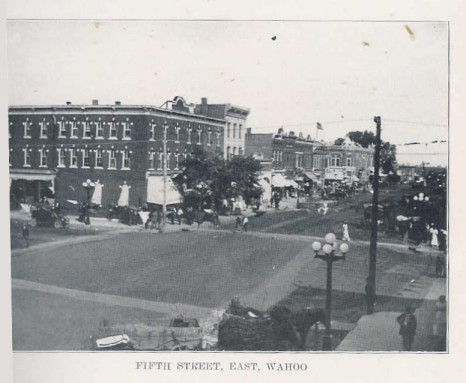
Fifth Street, East, Wahoo
PAST AND PRESENT OF SAUNDERS COUNTY 81
passed a resolution refusing to recognize his authority. The bonds of the city clerk, police judge, engineer and marshal were placed at the sum of $500; of the city treasurer, $2,000; and of the mayor, $1,000. At a regular meeting of the city council January 10, 1879, Mayor Knapp appointed the following committees: Burr and Koudelle, fire and water; Lyle and Bell, finances; Gregory and Clapp, streets and alleys. At a regular meeting of the city council held July 27, 1878, proposals for two No. 5 champion chemical fire engines and one No. 3 hook and ladder truck, with complete outfit, were presented and accepted. An order was passed to issue the city's coupon bonds to the amount of $2,000, in sums of $100 each, bearing 8 per cent interest, payable at the First National Bank of Omaha, upon the arrival of the apparatus at Wahoo. This was the first formal .step toward obtaining fire protection for the town.
The election for 1879 was held April 9 and the following were the successful candidates; E. E. Lyle, mayor; S. H. Sornberger, police judge; Mr. Johnson, clerk; Charles Perky, treasurer; W. H. Dickinson, engineer; Aimer Reynolds, marshal; E. Pickett, N. H. Bell, A. Anderson, councilmen.
Now comes the period when the town had to revert from the city government to the village form of control. This was made necessary by the act of 1879, passed by the Legislature, compelling a town to have 1,500 inhabitants in order to enjoy the city franchise of the second class. At a special meeting of the city council held March 18, 1880, a call was issued for an election to be held April 6, 1880, for the purpose of electing a village board of trustees. The successful candidates in this were: F. M. Stratton, E. Pickett, John Joseph, N. H. Bell and Thomas Killian as a board of trustees. F. M. Stratton was elected president of the board; C. S. Johnson appointed clerk; diaries Perky, treasurer; E. Pickett, T. Killian, committee on finance; T. Killian, N. H. Bell, committee on fire and water, N. H. Bell and John Joseph, committee on streets and alleys.
The Town of Wahoo remained under the village government until 1886. F. M. Stratton, Henry Anderson, E. E. Lyle, Henry Johnson and E. Pickett were successively at the head of the board of trustees, and C. S. Johnson, H. O. Beatty and C. M. Copp occupied the office of clerk during these years.
82 PAST AND PRESENT OF SAUNDERS COUNTY
In 1886 Wahoo again fell under the class of city government. The first election under this organization resulted as follows:
C. M. Copp, mayor; Charles Perky, treasurer; D. A. Clark, R. M. Gilson, clerk; W. Ault, engineer; F. P. McCutchan, police judge; C. H. Lubker, F. J. Lepsa, F. M. Stratton, C. A. Collins, George Frush and J. J. Willey, councilmen.
Wahoo has remained since 1886 a city of the second class. The following men have served as mayor of the city: C. M. Copp, 1886; W. H. Dickinson, 1887-88-89; Thomas Killian, 1890-91; Charles Perky, 1892; Thomas Killian, 1893; F. J. Snyder, 1894; John S. Wilde, 1895-96-97; H. K. White, 1898; John F. Sherman, 1899; R. A. Heaton, 1900-01; F. M. Stratton, 1902-03; Charles Perky, 1904; Ed Lehmkuhl, 1905-09; J. C. Hamilton, 1910; L. H. Lyle, 1911; C. L. Mielenz, 1912; James Kearney, 1913; W. J. Lehr, 1915.
The city hall at Wahoo was erected in the year 1890 and cost the sum of $12,000.
The growth of the City of Wahoo as a city did not begin with full vigor until about twelve years ago. The first step in the direction of a first class town, municipally and otherwise, was the organization of a Commercial Club, with the purpose to increase the improvements and industries of the town and to devote every effort to municipal betterment. Under this stimulus the citizens of the town have worked hard and a well-ordered and thriving city is the result. Not the least of the accomplishments is the acquiring by the city of all the utilities, an account of which is mentioned elsewhere. Another step was the bonding in favor of the new courthouse, the $8,000 bonds for the west ward school building, $15,000 in bonds for a good sewerage system, $65,000 in bonds for the electric light and water system and just recently $60,000 for a grade and high school building. An elaborate system of electroliers has been installed on the downtown streets within the last five years and all unsightly poles and wiring has been eliminated. Economically, the city has been well governed and is enjoying a well earned profit and prosperity.
THE POSTOFFICE
The postoffice at Wahoo was established in the year 1869 and James Lee was the first postmaster, keeping his office in his
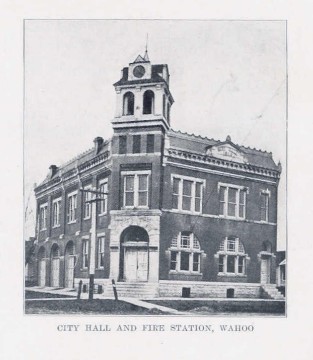
City Hall and Fire Station, Wahoo
PAST AND PRESENT OF SAUNDERS COUNTY 83
merchandise store, the latter the first also in the town. He will be remembered as one of the Lee brothers who first claimed land on the site of Wahoo and one of the proprietors of the town. Following is a list of the postmasters since this time, with their assistants:
Sarah E. Alexander, 1874-1878, Pearle Davis, assistant; John Steen, 1878-1883, E. M. Merriam, assistant; Joseph X. Davis, 1883-1887, Charles Pierson, assistant; Charles J. Harrison, 1887-1891, George E. Loder, assistant; Robert J. Kenney, 1891-1894, George E. Loder, assistant; John F. Sherman, 1894-1898, Mrs. John F. Sherman, assistant; John A. Anderson, 1898-1907, Karl A. R. Anderson, assistant; William T. Mauck, 1907-1915, Mrs. William T. Mauck, assistant; Nelson J. Ludi, 1915--, Mrs. William T. Mauck, assistant.
In 1913 the United States Congress appropriated $50,000 for the erection of a postoffice building" in the city and a lot was purchased in the block east of the city hall. This building has not been constructed, however, and now the postoffice is housed in a building next to the Killian store, pending the erection of the new building.
BANKING IN WAHOO
The pioneer of the banking business in Wahoo was Henry Anderson. Mr. Anderson was born in Norway on December 18, 1845. With his parents he emigrated to the United States in 1853. He came to Nebraska in 1863 and located at Omaha, where he engaged as assistant postmaster from 1865 until 1869. In the spring of 1870 he was employed in the Omaha National Bank as teller and remained there one year, then went into the First National Bank as bookkeeper, and in August, 1872, removed to Fremont, Neb., and started a lumber yard, which business he pursued until the fall of 1875, when he came to Wahoo, with a small iron safe and $200 in money, and started the bank which was the first in the town, and of which the First National Bank of the present day is the outgrowth.
The First National Bank was organized as a national bank on July 15, 1882; Henry Anderson was the real organizer, and the first president of the institution. Peter Anderson was the first cashier and J. M. Chapman the first vice president. The
84 PAST AND PRESENT OF SAUNDERS COUNTY
bank at that time had a capital stock of only $50,000, which has been increased to $80,000 at the present time. Since the time of organization tills bank has had a steady rise in business and prestige, until now the deposits average about five hundred thousand dollars and a surplus, with undivided profits, of $20,000 is carried. Charles Perky is the president of the First National Bank; Ed Lehmkuhl is the vice president; Oscar Hanson the cashier; and Ernest Hanson and L. J. Kudrna, assistant cashiers. The bank during its many years of existence has rested upon a solid foundation and has won the confidence and respect of its patrons. It is in the front rank of the twenty-eight banks of Saunders County.
The Citizens State Bank of Wahoo was organized May 8, 1895, by E. J. Collins, H. A. Lyle, Henry Hastings, C. A. Collins, and E. E. Lyle. The charter was granted by the banking board of May 15th of the same year. This institution was preceded by a private bank which began business in 1882 under the banking firm of Lyle and Collins. The first officers were: E. E. Lyle, president; Henry Hastings, vice president; C. A. Collins, cashier. The first capital stock was $20,000. At the present time the officers of the bank are: J. M. Ohslund, president; Emil Benson, vice president; C. J. Ficenec, cashier. The institution has been under the present management since May 18, 1912. The capital stock is now $30,000; the surplus and undivided profits, $2,000; and the deposits average about $225,000.
The Saunders County National Bank was organized in 1884. W. C. Kirchman is the president of this institution; F. J. Kirchman is the vice president; and J. J. Johnson is the cashier. The capital stock is $50,000; the surplus $41,000; and the deposits average about $375,000.
The Dorsey brothers were other early bankers in Wahoo. They operated a private bank.
NEWSPAPER HISTORY
The City of Wahoo now has two newspapers-the Wasp and the Democrat. Both of these publications are of excellent composition, of high standing, noted for their fair presentation of the latest news, and carry a great deal of influence among the
PAST AND PRESENT OF SAUNDERS COUNTY 85
people of Saunders County. Mr. T. J. Pickett is the editor of the former paper and Mr. Nelson J. Ludi of the latter; both plants are modern in their mechanical equipment, having the improved linotype, the best presses for the volume of business conducted, jobbers, card presses, stapling machines, cutting machines and mailing machines. The editorial character of the Wahoo papers is very high, ranking well among the smaller papers of the State of Nebraska.
The ancestry of these papers dates back many years. From the records we learn that on Thursday, September 16, 1875, H. D. Perky established the Independent at Wauhoo (as the name of the town was then spelled). The office was moved from Ashland, having formerly been the Ashland Times, and bought from Ed J. Hall. At that time the Nebraska Reveille and the Saunders County Republican were on hand and fighting the various battles of the early settlers. The first issue of the Independent contained a two-page, nine columns each, supplement to submit bonds for the assistance of the railroad. Each precinct had an individual bond election for the Nebraska Central & Black Hills Railroad north and south and the Union Pacific east and west.
On November 4, 1875, appeared the names of H. D. Perky, J. F. Richhart and J. S. Perky as publishers of the Independent. This partnership continued until 1876, when Mr. Richhart withdrew from the firm. On January 20, 1876, Henry Anderson located the first bank in Wahoo and the event is given ample space in the columns of the paper.
On April 5, 1877, J. B. Davis purchased the Independent and continued as editor and publisher of the paper until July 12th of the same year. At this juncture the Saunders County Republican consolidated with the former paper, the new consolidation retaining the name Independent. The publishers at this time were Davis & Andrews. On May 23, 1878, Andrews sold out his interests and withdrew. On April 1, 1880, A. U. Hancock entered partnership with Mr. Davis and became local editor. The firm of Davis & Hancock discontinued April 6, 1882, when Hancock retired. Then John Schram became associated with Major Davis and the paper was operated under the firm name of J. B. Davis & Company until July 1, 1886, when it was sold to John A. Macmurphy. On October 14, 1886, Macmurphy took active charge of the Independent and carried out his prearranged plans
86 PAST AND PRESENT OF SAUNDERS COUNTY
of consolidating this paper with the Wahoo Tribune, then published by H. O. Beatty. The latter became a partner and local editor of the Wahoo Wasp, while Macmurphy was the editor and manager. Macmurphy sold the office to a stock company and it was conducted for a few years by Smith & Schram, after which Wright & Pyle ran the paper for a time, then Schram & Ball. The latter firm had the paper for a year and then were succeeded by the present editor, T. J. Pickett.
The first owner and publisher of the Democrat was R. F. Davis, beginning with the year 1887. In May, 1889, Hamlin Palmer and Carter Hutchinson bought out Davis and operated the paper together until the next month, when John F. Sherman purchased the interest belonging to Hutchinson. On October 4, 1890, Sherman also bought out Hamlin Palmer, and then conducted the paper alone until June, 1902. Then the present owner and publisher, Nelson J. Ludi, took charge. Mr. Ludi is ably assisted in his newspaper work by his sons.
The Tribune was started in Wahoo in July, 1880, by T. J. Pickett; he then resided at Ashland and shortly withdrew from the publication. The Wasp was born in the basement of the Citizens State Bank at that time. The present editor assumed charge July 1, 1895. The date of consolidation of the Tribune and Independent was November 1, 1886. The old Republican had been started in Wahoo in August, 1876, by J. A. Thompson.
The first edition of the Independent was printed in the restaurant of Harrison and Lemaster and the first job printing done was the supplements for Saunders County Republican, the Wahoo Reveille and the Independent. These were the railroad propositions. An early paper says; "The Independent started to give the county the railroads; the Ashland Times was bought because it was against the bonds; the Republican was wrapped up in politics; and the Reveille was setting up pins to clean out the ring, so that the county was virtually without a paper to lay the bond situation before the people."
MISCELLANEOUS NOTES OF INTEREST
January, 1877--There was quite an amount of discussion at this date of moving the state capital from Lincoln to Wahoo. However, the accomplishment of this never came to pass.
PAST AND PRESENT OF SAUNDERS COUNTY 87
February, 1877--Meetings were held all over the county, attended by the farmers and townsfolk, to devise some manner or means of combatting the grasshoppers which had swept down upon the county by the billion.
March, 1877--At this time came the discussion of changing the name of Wauhoo to Wahoo. J. J. Hawthorne of Fremont explained that the name was of Indian derivation and should not be changed. He said that the misspelling occurred when the post-office was asked for in the little town, although the people asking for the office had spelled the word right--Wauhoo. The name, however, was changed to Wahoo; the medicinal compound known as Wahoo Bitters was frequently mentioned in this connection.
1877--Sixty Ponca Indians camped one-half mile below town on 'Wahoo Creek. A collection was raised by the people and presented to the bucks, of which the party was composed, and they returned the favor by performing a war dance.
The old part of the Town of Wahoo was called "Jericho;" the business part, "New Jerusalem;" the east part, "New England;" Stocking's Addition, "Solid South;" courthouse ridge, "Observatory Point;" and the depot, "Flat."
November, 1877--Sale of town lots in Wahoo. It will be remembered that when the county commissioners settled with the town company in the matter of relocating the county seat at Wahoo they took 175 lots in consideration of which the town company was relieved of the $7,000 bond. The action of the commissioners was condemned and denounced as a fraud. When the lots were sold, however, the matter was reversed and the people were lavish with praise, as twenty-six of the lots netted the county $4,878, leaving but 147 lots to add the $2,124 necessary to balance the $7,000.
In November, 1876, the town windmill was dismantled.
Mrs. R. N. H. Kelley was the first lady to ride over the O. & R. V. Railroad in the county.
The advertisements in the Wahoo Republican for September 1,1876, included the following: J. Manners & Company, general store, Ashland; Doudna & Coleman, machinists and blacksmiths, Ashland; A. W. Vandeman, grocer, Ashland; H. H. Shedd & Company, Palace Clothing House, Ashland; T. Jay Chastarn,
88 PAST AND PRESENT OF SAUNDERS COUNTY
harness and saddles, Ashland; O. M. Carter, hardware, Ashland; J. H. White, pianos and organs, Wahoo; James M. Lee, general merchandise, Wahoo; Henry Anderson, banker, Wahoo; Barnes and Reid, tinware, Wahoo; F. S. Steward, livery, Wahoo; I. Soule, physician, surgeon and dentist, also City Drug Store, Wahoo; Frank Koudele, meat market; F. C. Williams and E. E. Lyle, real estate and insurance, Wahoo; Joseph Arnold and H. A. Alden, attorneys.
Other ads in early Wahoo papers were for the following: E. B. Phelps, grocer; John Beermaker, hardware and stoves; C, M. Burr, general store; J. B. Alien, grocer; I. E. Phelps, contractor and builder; Wahoo Bakery, A. W. Mills; Perky and Gilkeson, Thompson and Reese, Mosher and Bell and George W. Burton, attorneys; Wauhoo Hotel, John S. Stevens; Deutsches Gast Haus, William Arndt; P. Andrus and J. W. Perkins, grocers; Mrs. J. W. Perkins and C. F. Steward, millinery; Dr. B,. B. Morton, P. Andrus, drugs; Simeon Decker, livery; Stephens and Manard, W. O. Thayer, blacksmiths; C. H. Adams, furniture; Riddle and Lemaster, saloon.
1876-R. D. Morgan announced that he had his steam ferry across the river at Ashland ready for business.
Stephenson's stage coach made four hours' stop daily, beginning at 7 A. M. daily. On Tuesdays, Thursdays and Saturdays the coach went to Lincoln, returning the same day.
One of the most disastrous prairie fires in the memory of the settlers swept the southwest part of the county on February 12, 1876. Another occurred on the 24th in Douglas Precinct. D. E. Sturdevant, James Welch, Hugh Alien and E. Bignell were the heaviest losers. This same year the Platte River Bridge at Fremont was washed out. The I. C. Flor mill dam also went out in 1872.
The ferry boat on the Platte river changed to what was known as old Anderson Bridge, 1 1/2 miles east of where it had been running.
The mills in the county at this time were owned by Messrs. Dean, Green, J. F. Roll and Flor.
In 1885 the Town of Wahoo had eleven saloons and all doing a big business. Now there are three.
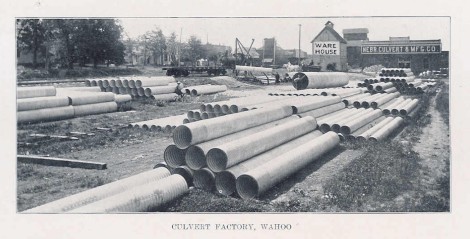
Culvert Factory, Wahoo
PAST AND PRESENT OF SAUNDERS COUNTY 89
The following business men have ads in the Wasp in March, 1887: J. Manners, general merchandise; H. Furman, general store; J. D. Newsom, Farmers Hotel; W. H. Dickinson, surveyor; Stiles Brothers, meats; John. Beermaker, hardware; E. B. Phelps, groceries; J. C. Stevens, Wauhoo Hotel; W. C. Cameron, barber; Joseph Snyder, shoemaker; Chicago Lumber Company; I. E. Phelps, contractor; Riddle and Lemaster, billiards; Henry Anderson, banker; J. B. Alien, groceries; C. S. Copp, attorney; K. Gray, physician; William Arndt, Central Hotel; Benjamin Talbott, livery; J. M. Lee, general store; Charles M. Burr, general merchant; Henry Johnson, livery at Ashland, also O. M. Carter, hardware, of the same location.
Among the things spoken of with pride by the citizens of Wahoo are the following: $12,000 city hall, twelve church denominations, artificial ice plant, wide streets, brick factory, opera house, florist and green houses, $85,000 courthouse, county fair grounds, two first class hotels, municipal waterworks, three grain elevators, municipal sewer system, flouring mill, three department stores, two excellent ward and new $50,000 high school, Government building site, two lumber yards, athletic park, wholesale bottling works, marble and granite works; butter and egg house, three railroads, municipal electric light, municipal cemetery, two cement block factories, cement culvert works, municipal electrolier system, horse hospital, fifteen miles cement walks, 99.98 per cent pure water, three company fire department, corrugated culvert factory, two newspapers, and three banks.
The question of a new city hall was first discussed in 1890. J. K. Gilkeson, H. H. Dorsey, E. E. Lyle and Charles Perky made speeches in favor of it.
Electric light was started in Wahoo in February and March of 1909.
WATERWORKS
The question of a waterworks for the City of Wahoo was first talked of early in the year 1887. The need of a good water supply was imperative to the growing town and on Wednesday, July 6, 1887, the city council passed an ordinance granting a waterworks franchise to the American Water Works Company of Pittsburg. This franchise covered a period of twenty years,
90 PAST AND PRESENT OF SAUNDERS COUNTY
the city to have the option of buying in ten years. This company was a large corporation, operating in forty states. In the contract the company was to have the use of the streets for laying their mains and were to supply water until January 1, 1909, for $2,500 per year. The intenion was to locate an engine house and pumps at the foot of Chestnut Street on Wahoo Creek. Mains were laid as follows: 10-inch from engine house up Chestnut Street to Mary's Avenue, thence east to Broadway, thence north to Second Street; here began an 8-inch pipe up Broadway to Fifth; then 6-inch was used up Broadway to Eleventh, thence east to Beach, thence south to Second, thence west to Broadway. A line of 4-inch pipe was laid from corner to Beach and Sixth east to Orange Street, thence north to Ninth, thence west to Beach; also 6-inch from corner Beach and Fifth west to Walnut, thence north to Seventh, thence north with 4-inch to Fourteenth. The total length was about four miles.
There was a great deal of delay in this matter of securing water for the city; there was thought, rightly, to have been a large amount of danger for the city to pursue the course outlined. A special election was held March 27, 1908, when the franchise of the water company had about expired, and the majority of the voters were in favor of having a municipal plant and casting off the yoke imposed upon the necks of Wahoo people by a foreign corporation. The quality of the water which had been supplied was very poor and much sickness and death had resulted. Experimental wells were sunk east of the Union Pacific tracks, a little south of Dolezal's elevator, by Crawford & Holtz. At a depth of eighty-four feet good water was found, with a flowing capacity of 375 gallons per minute. Sixty-five thousand dollars was voted for the purpose of establishing a plant owned and operated by the city. Following up the general business methods which they had formerly used, the American Water Works Company discredited the bonds issued by the city, as they desired to hold their interests here and impose taxes on the people as well as interest on the supposed $60,000 mortgage, which was later found to have been $75,000. Three banks refused to recognize the bonds, except the Saunders County National. Then W. C. Kirchman, F. J. Kirchman and J. J. Johnson bought $50,000 worth of the bonds and the city was relieved.
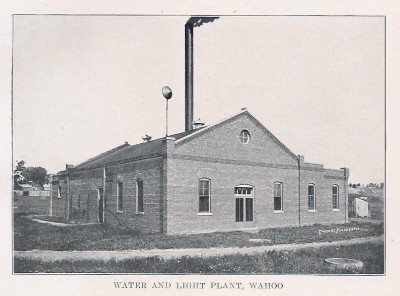
Water and Light Plant, Wahoo
PAST AND PRESENT OF SAUNDERS COUNTY 91
When the Wahoo Water Works Company commenced to negotiate with the city for the purchase of their plant, they placed the price too high. The first proposition made to the city was that if the city would assume the $60,000 for which the water company was bonded, the company would turn the plant over to the city. No headway was made in this direction. The city advertised for bids and were about to let a contract when an injunction was served on some technical grounds. The city, in order to separate the two propositions and to have an engineer's estimate appear on the notice calling for bids, called off the letting of the contract and readvertised for new bids. It was generally understood that the council was in favor of giving $18,000. This fact was communicated to the water company and they agreed to sell the water mains for that sum. This haggling continued for some time, until the city officials changed their minds, and on Saturday, July 25, 1908, the entire plant was sold to the city for $17,500, possession to be given the city on August 1st.
The city officials at this time were: Ed Lehmkuhl, mayor; L. H. Lyle, clerk; John E. Martz, engineer; Alfred Helsing, treasurer; N. D. Tharp, C. L. Mielenz, Edward Killian, S. P. Wahlstrom, Oscar Lent and R. F. McCreery, councilmen. The legal counsel secured for the city was composed of Charles H. Slama and H. Gilkeson.
Wahoo has the comfort of knowing now that a plentiful water supply is secured for the city, under the control of the city, and profitable to the city. The water is chemically pure and is supplied in good,, quantity, both for domestic use and for fire protection.
|

